Liquid dish soap does a fine job of cleaning dishes, but I cringe every time I have to buy a plastic bottle full of soap. I had an epiphany about homemade dish soap several months ago, and I’ve been experimenting. If — like me — you’re trying to cut back on single-use plastic, this solid dish soap might be just the solution you’ve been looking for.
Check out this recipe for homemade liquid laundry soap, too!
Originally published July 2019; this post has been updated.
How I Wash Dishes by Hand
My dishwashing method has changed over time. I grew up in a house without a dishwasher. For our dish washing duties, we filled the kitchen sink with hot water and bubbles and then stacked dishes in the sink.
As we washed each plate or cup, the water in the sink got colder, less bubbly, and dirtier. If you wash dishes like this, you know what I’m talking about.
When we moved to Hawaii, I began seeing a method of washing dishes that I’d never seen before. Imagine — such a simple chore, but done completely differently in another part of the world! I’ve completely converted to this method for hand washing dishes.
Take a Peek Inside My Book!
Get a free excerpt from my book, Attainable Sustainable: The Lost Art of Self-Reliant Living! You’ll also get my free weekly newsletter, complete with recipes, gardening tips, and a little peek at what’s going on around here — both the zany and the mundane.
Instead of filling a big sink, I now fill a medium-size bowl with hot water. None of the dirty dishes go into the water, so the water always stays clean.
To wash each dish, I dip a dish rag or sponge into the hot water and then squeeze on a bit of dish soap. The suds transfer to each dirty dish as I clean it, getting sudsy and clean. I repeat this with all of my dirty dishes, wetting the sponge and recharging it with dish soap as necessary.
This method works beautifully, but there’s still the question of the plastic bottle. Not to mention that store bought dish soap uses some harsh ingredients.
A Vintage Solution: Solid Homemade Dish Soap
Then I remembered my mom telling me that my Grandma used to make tallow bars to wash laundry. Instead of the powder or liquid that we use today, she’d cut off a piece of the soap bar and toss it into the washing machine with the dirty clothes.
This made me wonder about using a solid homemade dish soap bar as an eco friendly option. Why not?
Before I made up a solid homemade dish soap specific for that purpose, I wanted to try the idea. I set a bar of homemade soap in a shallow bowl and began using it instead of liquid soap. It worked perfectly well! The dishes came out clean and my sponge was suitably sudsy. The only trouble with this method was that the soap did get quite soft in the bowl. This told me that I needed a harder bar.
I started poking around the internet for a recipe without much luck.
Further searching left me looking for a laundry soap bar and I landed on my friend Jan’s recipe. (By the way, I credit Jan for giving me the confidence to start making my own soap. Check out her Soapmaking ebook collection here.)
Jan’s recipe is made with pure coconut oil. I didn’t have enough coconut oil on hand, so I used a soap calculator to figure out how to use half coconut oil and half tallow. And instead of forming this recipe into bars, I poured the batter into shallow bowls that I picked up at the thrift store.
I ordered a handmade sponge — like this one — from Etsy. But on my list of projects to try is one of these homemade reusable sponges.
Note: I’ve had a LOT of people ask about using alternative oils. If you need instructions for making a vegan soap block, scroll to the notes section of the recipe at the bottom of this page for the appropriate measurements. Or, you can purchase a vegan soap block here.
Making a Solid Dish Soap Bar
This is a cold process soap recipe. This method calls for combining oils with sodium hydroxide (aka lye).
Lye is caustic, so you’ll need to use caution, but please don’t let this scare you away from making it, since soap making is really not difficult!
Begin by pouring the lye into the water. (Never pour water into lye.) Stir carefully. Combining the water and lye will create a chemical reaction and the water will become VERY hot.
Meanwhile, melt the oils in a saucepan. When the lye mixture and oils are both about 100ºF, add the lye to the oils in the saucepan. Mix until the soap reaches trace. This is easiest when done with an immersion blender. You can stir by hand but it will require a lot of stirring!
Soapmakers use the term trace” to describe the consistency of the soap batter when it’s ready to be poured into molds. When the soap begins to look like cooked custard and holds its shape across the top, you’ve achieved trace. There’s not an exact science to this. The level of trace can range from light (thinner) to heavy (thicker). Mixing the batter until it reaches heavy trace allows for layering soap of different colors, since it holds its shape to support additional layers.
Pour the soap batter into a mold. I like using a shallow bowl for this dish soap recipe, but you could also pour it into a larger mold and cut it into bars.
Let the soap cure for 3-4 weeks before using. If you’ve opted to use one large mold, now is the time to cut it into dish soap bars.
Using this Homemade Dish Soap
I keep the bowl of hard soap right next to my sink. If I’m washing a lot of dishes, I’ll fill up a container with hot water and dip my sponge in that as I wash.
If I just need to clean a few dishes, there’s not even any need to fill a bowl — I just wet the sponge with hot water, then rub it on the hard soap until it begins to foam.
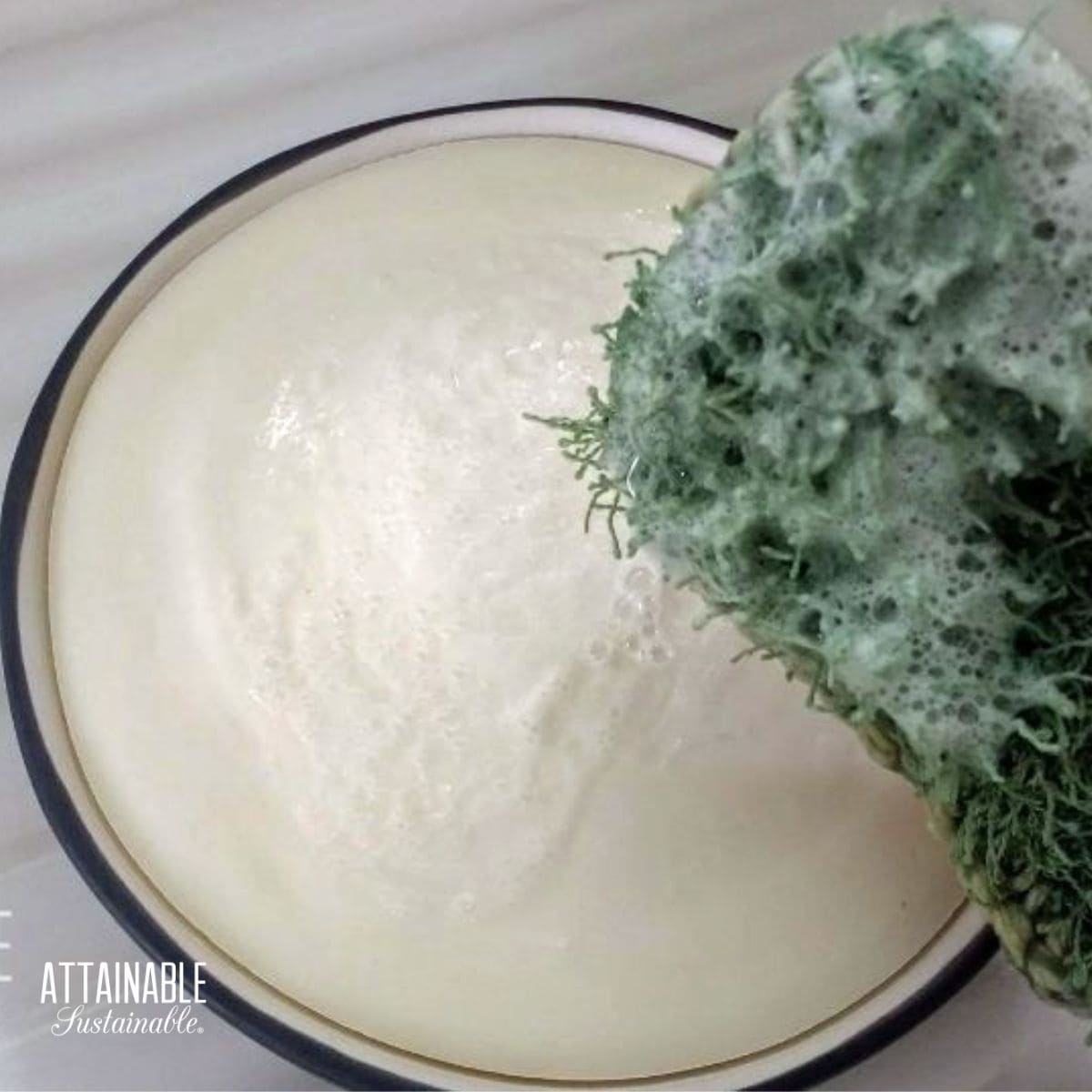
One thing to note. By the time you get to the end of the soap bar, it can start to look a little…gross. It helps to drain off any water that may have puddled in the dish when you’re done washing dishes. (This will also extend the life of the soap.)
Another tactic is to go small with your bar dish soap. Use small bowls or cut bars into small pieces.
Making Dish Soap
Home made dish soap is not difficult to make, but you really do need to follow some basic safety precautions.
- Always wear goggles and long sleeves when working with lye.
- Measure ingredients exactly. You will need a scale in order to make soap at home. There’s no getting around this.
- Never pour water into lye; instead, measure the lye into the water.
Soapmaking Success E-Course
If you’re ready to dive into soapmaking, check out Jan’s Soapmaking Success e-course! It includes six lessons that will have you making soap like a pro in no time. It includes:
- Incorporating fruits & veggies
- Soapmaking with flowers & herbs
- Using alternative liquids
- Using natural colorants
- Simple soap designs
- Designing soap labels
You should also give Jan’s basic soap bar a try.
★ Did you make this homemade dish soap? Don’t forget to give it a star rating below! ★

Homemade Dish Soap Bar
Equipment
- Shallow bowls
Ingredients
- 4.45 ounces sodium hydroxide lye
- 9.96 ounces water
- 14 ounces beef tallow
- 14 ounces coconut oil
- 1 - 2 tablespoons essential oil lavender or citrus are great
Instructions
- Measure the water into a non-reactive heatproof container.
- Carefully pour the lye into the water. (Never pour water into lye.) Stir carefully. Combining the water and lye will create a chemical reaction and the water will become VERY hot.
- Set the lye mixture aside. While the lye cools, heat coconut oil and tallow to about 90 to 100°F. The tallow will take longer to melt than the coconut oil. If you achieve the desired temperature before it's completely melted, just turn off the heat and let the mixture sit for a few minutes. The residual heat will melt the tallow all the way.
- Pour the lye solution into the warm coconut oil and stir by hand briefly. (Note: The lye and oils should both be about 100ºF when you combine them; you may need to allow the lye mixture to cool a bit.)
- Use an immersion blender to bring the soap to trace.
- Incorporate essential oils.
- Pour soap into shallow bowls and allow to cure for 3-4 weeks before using.
Using this solid dish soap
- Wet sponge and rub onto soap until suds form.
- Use sudsy sponge so thoroughly wash dirty dishes.
Notes
- Always wear safety goggles and long sleeves when making soap.
- Never pour water into lye (pour lye into water).
- Using lavender, orange, or lemon essential oils gives this homemade cleaner a light fragrance.
To make a vegan soap block
Follow the instructions above using the following measurements:- 28 ounces coconut oil
- 11.15 ounces water
- 4.98 ounces lye

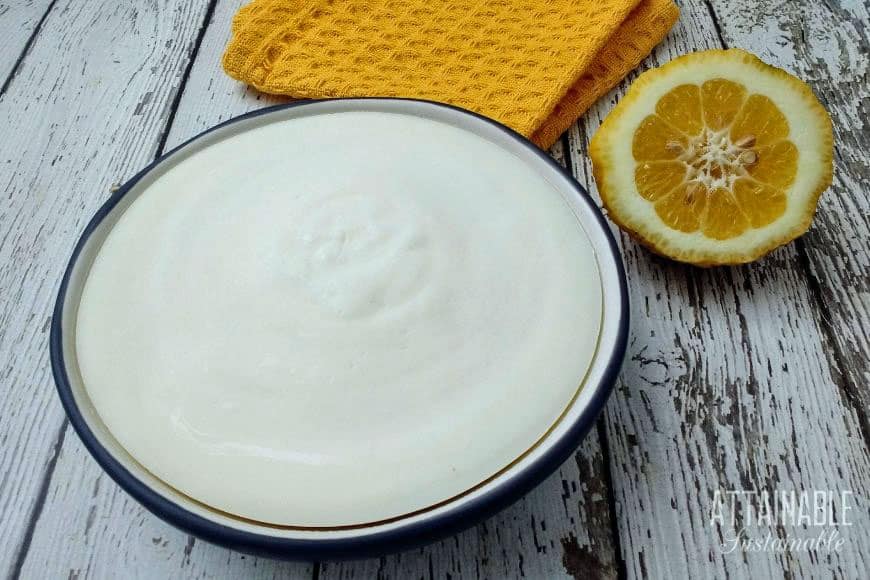
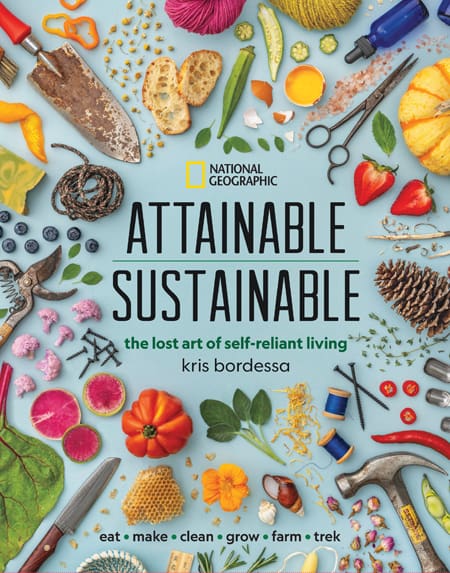
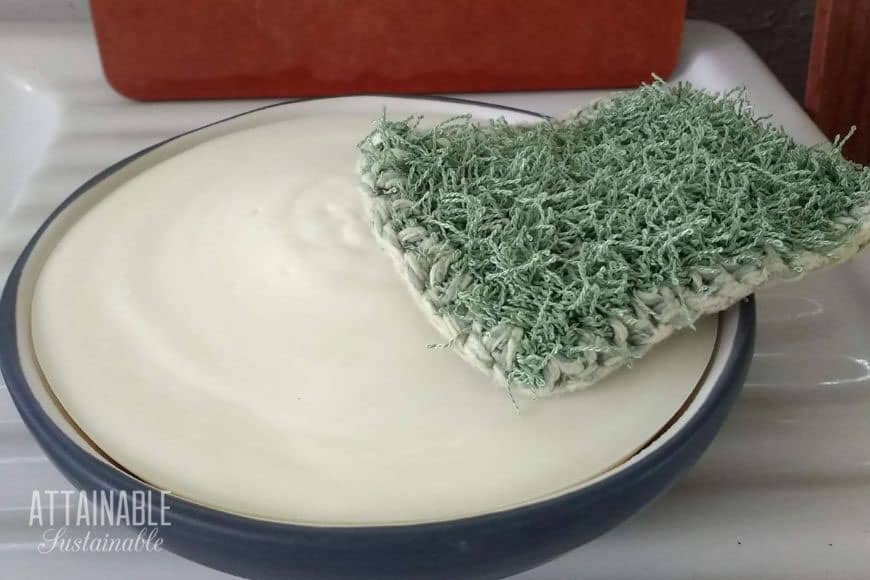
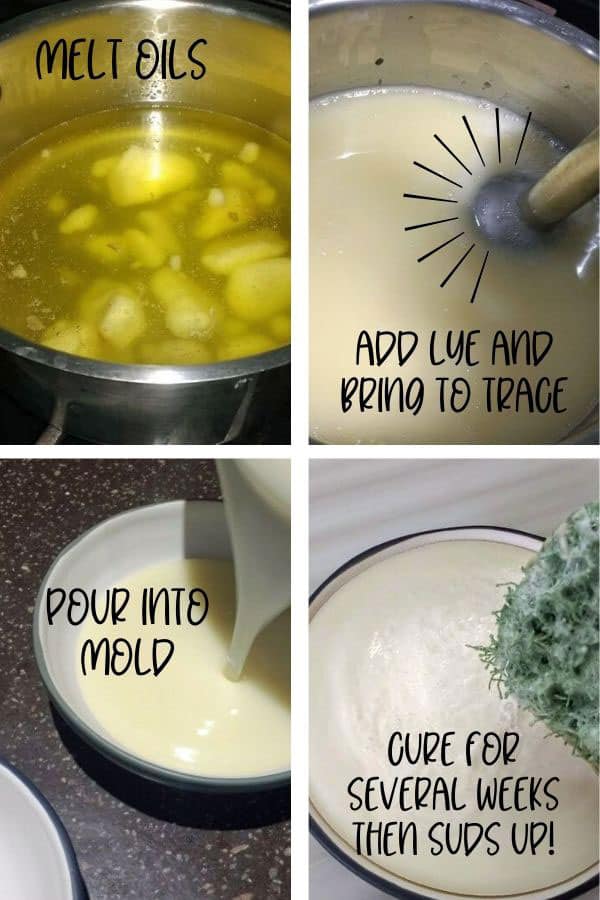
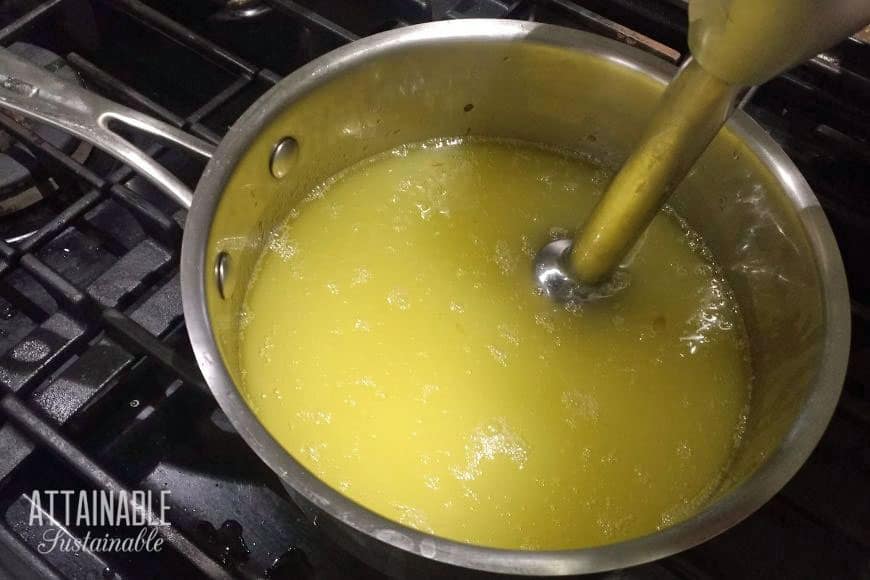
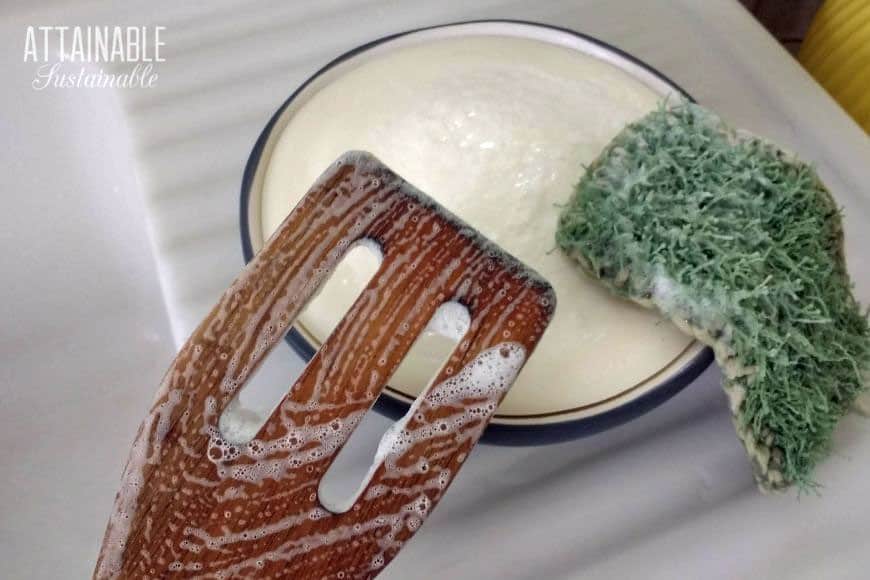
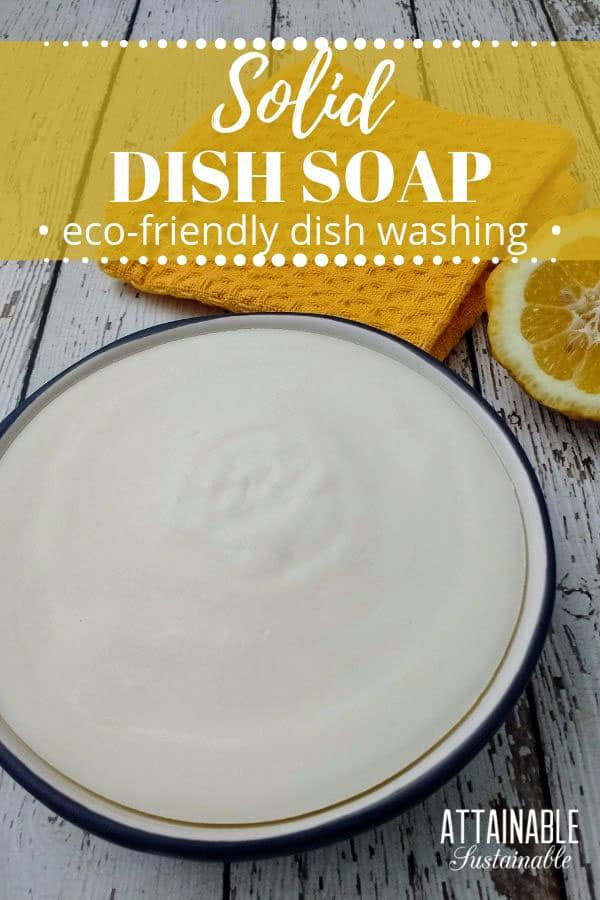

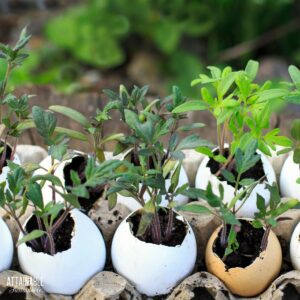
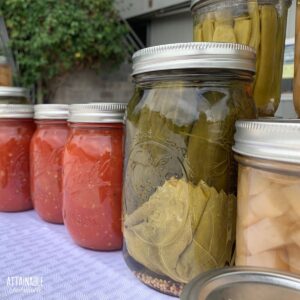
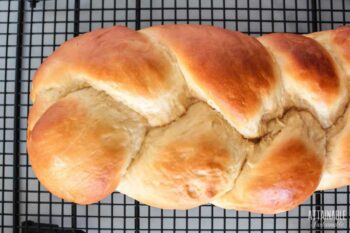
Hi. I’ve read in some places that the immersion stick can’t be used for food mixing again after you have made soap with it. Surely if you clean all the tools, bowls etc with soap and boiling water. I’ve also heard the same for jugs bowls and measuring tools. I love the idea of making SOME soap and your recipe looks amazing. It kind of defeats the purpose though if you can’t use what you already have available. Looking forward to hearing some thoughts.
I use equipment I have in my kitchen, for the same reasons you state.
Great idea but be careful using a saucepan making soap… metal can affect the chemical reaction. Best to use glass or plastic or a crockpot if making hot process. Also, curing time for cold process should really be 4 weeks or there may still be lye present in the soap. If you get in in your eyes or even on your skin it will burn… trust me!
Funny, I just had someone else tell me that curing wasn’t necessary at all! 😉
Hi, thank for the recipe and also replying to all of the comments. I am planning to use a large soap mold. My question is at what point do I cut the soap into bars?
Let the soap cure for a minimum of two weeks, then you can cut it into dish soap bars.
love homemade versions of things.
I started making homemade soap about 12 years ago. It is great fun, you feel like a mad scientist in the kitchen. I use only home made soaps for person hygiene, yes I have a bar soap for shampoo. I don’t often wash dishes by hand, but I will think on this method. It’s never too late to change.
I appreciate the thought of reducing plastics, but don’t all the ingredients needed to make your soap come in plastic?
Some do. But one plastic bottle of lye can make numerous bars of solid soap. Not plastic free, but less.
We are making this and wondering how long it takes for it to harden in the bowl?
It should be hardened within the 2-week curing time.
I am looking to use tallow, and your recipe came up, but then your recipe is for coconut oil. Do you have one that uses tallow? Thank you!
The recipe calls for both tallow and coconut oil; I don’t have one for straight tallow currently.
I had skipped to the bottom and just saw the vegan one! I see now you have tallow and coconut oil in the other one! Approx. what size are your little shallow dishes? This is a great idea for a gift, so I am going to go thrifting to find some of those! Thank you for your help!!
The only tallow im finding is food grade… Is that ok to use ?
Yes! 🙂
Can I substitute tallow for olive oil?
Any alterations to the oil should be run through a soap calculator, as each oil differs.
Oh, I love this, and need to read it again! you have the basics laid out so clearly! Great job,
Hi! This looks great! I have never made soap before and have read all the comments so I was sure not to repeat, but can you tell me why you use the beef tallow? If I go the vegan route(though I’m not and would be fine doing the tallow) is it less effective, or less of any kind than using the tallow option? I have just also never rendered beef and have coconut oil on hand so before I dive in and end up with a less superior product just thought I’d ask the experts in soap! Thanks!!
I haven’t noticed a difference in effectiveness between the two. Beef tallow is something I can get locally, but coconut oil is fine!
I love this soap and I will definitely be using this recipe again
I’m so glad! (I love it, too!)
This recipe is about identical to my homemade Laundry Soap recipe except that I use LARD (Manteca) which is all calculated with a Soap Calculator. In fact, I just made a double batch today and use Lemon Grass scent. Then in a couple of days, I use the grater blade in an old food processor and then spread it out to dry for a few more days while stirring it about occasionally to help it dry evenly. Then I will put it back in an old food processor with the knife blades and chop it down as small as I can possibly get it. It’s a fabulous laundry soap.
I also make our own bar soap and bar shampoo. It’s all we like to use. The bar soap I make from LARD and the shampoos, I make with Olive oil. My wife also uses the shampoo for a face wash since I add Bentonite Clay into it. She LOVES it for cleansing her face better than the soap even.
I worked long and hard to perfect my recipes and as far as I’m concerned, they’re all PERFECT for what they’re intended to do as far as cleansing, moisturizing and the rich, luxurious lather of the soap and shampoo is amazing.
The products are also very LONG LASTING. A bar of soap will last about double of a store bought bar and the shampoo bar will out do two or three bottles of shampoo. People who have tried our products just can’t believe it.
They absolutely love them.
Lye will severely burn you if not handled properly. Go to YouTube and search for some ‘Beginner Soap Making’ videos. Learn proper safety and follow them to the letter.
Also, go learn to use a Soap Calculator at this web site http://www.soapcalc.net/calc/SoapCalcWP.asp
Each oil takes a different amount of Sodium Hydroxide (LYE) for proper saponification and each ingredient must be weighed EXACTLY or your product may not turn out or could actually be DANGEROUS.
Learn HOW to do things safely and don’t attempt this if you don’t know the safety rules FIRST!!!
Follow the rules and you can and you can make some amazing products that are much, much better for you than the garbage you buy in the stores that are full of chemicals that aren’t good for you.
Good Luck!!!
Terry, would you mind sharing your shampoo recipe? I’ve been s on the hunt for one that works well. Thanks!!!
Are u able to post your recipes for all.of those? I have been searching for good recipes for hair!
Terry, would you mind sharing your shampoo and bar soap recipes? I’ve been trying different recipes for shampoo bars but haven’t found one I’m happy with or I should say that my hair is happy with, thank you! 🙂
Do you have your recipes available Terry?
The amount of lye ito be used s not listed, just a link on where to buy it. A friend of mine gave me 2 quarts of tallow so I would love to try this recipe.
Thank you
Hi, love the recipe, but for whatever reason it’s not showing me the amount of lye I need to use in this recipe, it just says get it here, it’s a link to buy lye. so excited to give this a try!!!! Thank you sir sharing
Thanks for alerting me — this has been fixed!
Hi, your recipe looks wonderful. I would like to try a batch, but I am wondering if you can successfully substitute most or all of the coconut oil with either lard or tallow? Would it affect the quality of cleansing too much? And the amount of bubbles? I would like to move more towards sourcing ingredients, as opposed to purchasing them. Thanks!
I haven’t used 100% tallow, so I can’t speak to that directly. If you change soap recipes, you’ll need to use a lye calculator: https://www.brambleberry.com/calculator
If you would use ALL lard or tallow, all you’re going to have is a big blob of MUSHY OIL with ZERO cleaning ability.
Go to this soap calculator and you can try try different things.
http://www.soapcalc.net/calc/SoapCalcWP.asp
Also go to YouTube and learn safe and proper soap making techniques.
Good Luck.
Seriously this is the best dish soap I have ever used! Thank you so much for sharing, I added a little lemon and lime essential oils to it just for an added disinfectant and scent. I couldn’t be happier. Thank you! BTW this makes an amazing gift!
I am so excited to try this! I love soaps and making my own makes sense!
I have some nice bars that I made last year that are very similar to this recipe. I used it for handwashing laundry for a few months when I washer was broken. Worked great! In the kitchen, I have noticed that bar dish soap tends to leave a slight haze on glasses and such. For rinsing my dishes, I use a small dish tub of hot water with 1-2 Tbsp white vinegar in it. No more haze, spots or anything! (and I let my dishes drip dry )
I have made this several times now, and I LOVE it. Thanks for sharing the recipe with us!
I’m so glad!
Coconut oil is terrible for drains!
The coconut oil saponifies and is not oil any more after that process. So…
Sounds like a great idea. I usually use a dishpan and put the dishes in it but I’m going to try your method. As wonderful as it is about trying to reduce plastic, remember that water is also a precious commodity. I hope that those of us washing dishes by hand are conscientious about water usage as well and don’t leave the water running while the dishes are being cleaned. Turn the water off between washing and rinsing, or wash a few dishes then rinse them.
Sorry to disagree with you, but if it’s water you’re worried about, it’s a fact that using a dishwasher will use less water than hand washing in a sink.
I’m a freak for trivia facts like this.
Don’t believe me? Just Google it.
Hi I would love to give this a try as I am trying to be more environmentally friendly but I am concerned that the lye sounds quite toxic, is it only toxic until it’s mixed or am I better sticking to eco products, really love the idea of blocks.
Lye needs to be used with caution, yes. But it’s required to make soap, no way around it. There is no lye in the end product, though, as it’s eliminated during the saponification process.
I am very impressed with both your ideas. First, the idea of using a small separate bowl of clean water and not putting dishes into that bowl.
Second, the bar soap for dishes.
Thank you for sharing these ideas.
How much soap do you get out of this recipe?
It depends a bit on the containers you use. I tried a batch with 6″ clay saucers, and I ended up with about 5.
I have a couple questions,
1st, do you only need to wait 2 weeks for this soap to cure? Usually its around 4-6 weeks. Maybe because the ingredient list is so short?
2nd, I LOVE the idea of putting the soap into a shallow bowl but does that make the soap disintegrate faster than if it was in block form sitting on a drying rack?
Thank you for your inspiration and your knowledge!
I won’t *hurt to wait longer, certainly. I tried it after the 2 weeks because I’m impatient and I wasn’t using it on my body. And you could totally make this as a block instead.
Could this recipe be made using individual soap moulds or poured into a large mould and cut into bars?
Thanks
Of course!
Thanks for posting this recipe. Lately I have been trying to eliminate as much single use plastic as possible. I have never made soap and am interested in where you source your lye and fats from. Have you been able to find any in non-plastic containers? I’ve looked around a little bit and am having trouble finding anything. Please let me know.
Thank you!
Jessica
I sourced the tallow for this locally and it came in a Mason jar. I’ve not found lye that doesn’t come in plastic. It’s hard enough to come by as it is. One plastic container (I’ve had jars and bags) of lye makes a LOT of soap, though, so I’m still using less plastic. It’s always a balance, right??
I’ve been making soap for years but I never ever thought of pouring it into a bowl for dishes. I’ve tried using homemade soap in place of dish detergent and it wasn’t very satisfactory. The water got cloudy and yucky fast. But I do believe this method would work wonderfully even with my hard, hard water. Thanks, Kris, for the inspiration.
Chris, I’m curious to hear how it goes, both with the hard water and changing the habit of filling a sink with suds to using a soapy rag/sponge!
Hello Kris, thank you for this great post! I am getting the ingredients together to give this a go :o) My daughter already had some tallon (rendered) in her fridge, but not enough, so I bought beef fat from the butcher to make up the difference. My question is: should I render the fat before adding it to the already rendered one? Will there be any residual after rendering? If yes, should this be removed? Never attempted making soap before so very ignorant about it all. Hoping to read from you soon, cheers Cinzia
Yes, beef fat will not work the same as tallow. Here’s an instructional on how to render the fat to make tallow: https://www.theprairiehomestead.com/2012/02/how-to-render-beef-tallow.html.
Thank you so much! As it turned out I did have enough tallow for the recipe. Just made it and it looks great… can’t wait for the two weeks to go by
Can’t wait to try this. Would this recipe work as bars instead of pouring into bowls?
Thanks Kris! I make my own dish soap, too. However, I make big solid blocks and keep one next to the sink on a cedar soap deck that my husband made. I love your idea of pouring it into a bowl, although I wonder if it would get soggy? (In our house we do LOTS of dishes, as there is 14 of us!)
So far, no. We just make sure not to leave water sitting on top of the soap.
Hello Kris! You’re heaven-sent. Thank you for this!
I hope you love it!
Great recipe. I’ll try it soon. Just wanted to comment on your sink. I had one very much like it when my adult son was a child. I loved that sink. Great for all sorts of projects that don’t work so well on modern counter tops.
There’s a long sad story that goes with this sink. It’s a *new sink, replacing a beautiful old cast iron one that was damaged beyond repair by a “refinisher.” I like this one, but LOVED the cast iron vintage one!
Hi can I use palm oil instead of coconut oil for the vegan recipe
I’m not sure what the weight would be on that as it varies oil by oil. You’d need to use a lye calculator. I’m not sure that palm oil is the best substitute for coconut oil for vegans, though, unless you’re using a (somewhat obscure) sustainably sourced option. (Deforestation due to the harvest is decimating the orangutan population.)
Do you really use 2 tablespoons of essential oils? That seems like a huge amount!
Yes, that’s accurate. The aroma dissipates quite a bit in the soap. You could certainly use less if you like, though.
Can I use lard instead of beef tallow? I could use coconut oil (As comments above), but I want to try it this way.
Please see the above comments and plug your proposed ingredients into the soap calculator.
Is there possibly a vegan alternative to the beef tallow?
See my comment above. There’s been enough interest in this, though, that next time I make it I’ll do a vegan version!
Can you just use coconut oil for this recipe instead of a mix of tallow and coconut oil? Will it work just as good on dishes?
Wee my comment above. I”m going to try this next time, because so many people have asked!
Could you add some washing soda into this at all to get cleaner dishes.
I’m not sure how the soap recipe would react to having washing soda added.
I’ve used just coconut oil and it worked awesomely well!
I just saw someone already asked my question. Sorry about that!
Hello! I love this idea! I have a friend who would try it if it’s vegan. Would you happen to know a good substitute for tallow? Or if a fat was added along with a soap “hardener”? I’m still going to make this but just thought I’d ask. Thanks!
That is a very cool looking sponge, did you make it or buy it? I think a bowl of soap and sponge prepped in a pretty ribbon will make great gifts!
Love that gift idea! I got those sponges from an Etsy seller: http://tidd.ly/8b525112
I can’t find this seller?
That’s the trouble with Etsy. Sellers run out of stock. Here’s another one to try: https://www.etsy.com/listing/280697112/sponge-kitchen-sponge-scrubbing-sponge
I’ve always wanted to try and make soap…but using lye freaks me out!! I know..when I make my first batch.. I’ll get over it !!
You will love it when you get over it. I do!
Jan Berry, the soap maker Kris talks about in this article, just came out with a melt and pour soap making book. Look for it on Amazon. It makes soap making so much easier because you don’t have to mess with the lye processing at all when you buy soap base for these recipes.
Thanks I’m going to try this. Do you have a recipe for laundry soap?
There’s a recipe for laundry soap in my forthcoming book!
Hi, this looks like an excellent idea. For the vegetarians among us, can we replace the beef tallow with the same amount of coconut oil? I think that’s what you were saying in the post.
See Ann’s comment (and my response) above.
Would you happen to know the amount of another oil to substitute for the tallow (not palm oil)?
You should be able to use all coconut oil, but to be safe, always run changes through a soap calculator: https://www.brambleberry.com/calculator?calcType=lye
I just did, and the water and lye weights change slightly.
Lye (Sodium Hydroxide) 4.98 oz
Ounces of liquid 11.15 oz
Coconut Oil 28.00 oz
What is your superfat percentage?
For a cleaning bar like this, I didn’t want extra fat. (I’m relatively new to soap making, so if you know something I don’t, please share!)
Today marks the third round of this soap. I Love,Love,LOVE this recipe!!! Thank you so very much for posting it. MY nine year old os quite the eco warrior and i made it the first time to avoid plastic. The next I made a triple Bach a few weeks beforehand Xmas and gave out dish soap bars as gifts. Friends who have run out are asking for more so I made another batch today. ❤️
This makes me so happy! Thanks for letting me know. (Our friends love it, too!)
I’m confused by step 3. It says to set the lye mixture aside to cool. I didn’t see where it said to heat the mixture in the previous steps. Do I heat the water and then add the lye? Do I heat them together? Am I bringing to a boil or just heating to a certain temp? Other people may know this already and wonder why I would ask, but this will be my first attempt at soap making. I just love this idea!
Excellent question! I’ll clarify this in the instructions. In short, though: When the lye and water are combined, there’s a chemical reaction and the mixture becomes very hot. You’re right in that there’s no cooking required!
Thank you. Now it all makes sense. I’m looking forward to trying this.
Lovely post. I have tallow but it’s not beef it’s sheep tallow do you know if tallow is interchangeable?
Sheep tallow should be fine!
Deanne – your lye calculator should have the different types of tallow listed separately, just choose the correct one, sheep in your instance, when calculating your ingredients
Thanks for this awesome idea! Green and clever. I’m inspired to make some of these soap dishes to give as gifts! How many shallow dishes would you say this makes approximately?
Depending on the size of the dish, 4-6.
Thank so much for sharing this. I can’t wait to try it.
Thanks for the inspiration… will make a batch and give it a go!
I hope it works well for you!
Screw “eco-friendly”.
This page is probably not for you, then!
Can I add Sodium carbonate to the recipe
This recipe has been calculated using the ingredients listed. I wouldn’t add anything without recalculating the ingredients.
so proud of this response..we enjoy your page